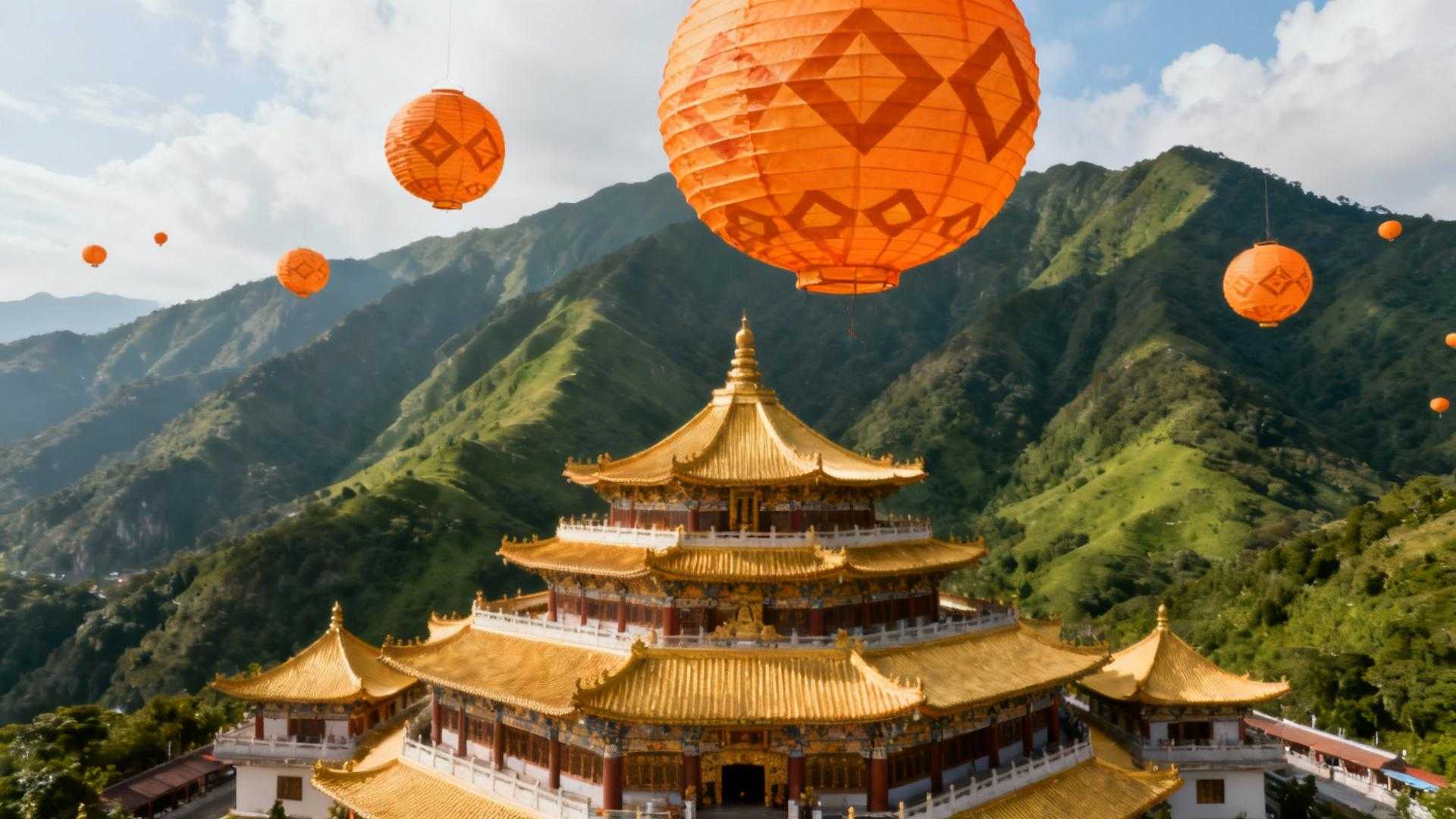I stood in Chiang Mai’s Tha Phae Gate square as darkness fell on November 5th, watching 10,000 khom loi rise simultaneously into the northern Thai sky. This wasn’t just another light show—this was Yi Peng, the only Buddhist lantern festival where ancient Lanna merit-making ceremonies transform an entire city into a celestial cathedral. While Burning Man charges $575 for desert dust spectacles, this 700-year-old spiritual tradition welcomes participants for $25, proving that authenticity doesn’t require exclusive price tags.
The Lanna kingdom’s most sacred festival occurs during the 12th lunar month’s full moon, when Buddhist practitioners release paper lanterns to symbolically carry away misfortunes and honor ancestors. Unlike commercialized light festivals, Yi Peng maintains genuine spiritual depth—monks lead temple ceremonies, families craft biodegradable lanterns together, and the entire experience unfolds against Chiang Mai’s mountain amphitheater creating a 360-degree illuminated sky dome.
The synchronized release that stops time
What makes 10,000 lanterns rise together magical
Mae Jo University’s organized release represents Yi Peng’s most breathtaking moment. At exactly 8 PM, thousands of participants release lanterns in perfect synchronization, creating what locals call “heaven touching earth.” The biodegradable rice paper lanterns climb 1,000+ feet on warm air currents, their candlelit glow reflecting off surrounding mountains. This mass ascension lasts 15-20 minutes, transforming Chiang Mai’s atmosphere into something resembling a Finnish glass igloo’s aurora view—except you’re inside the light show, not watching through windows.
The Buddhist framework behind the beauty
Yi Peng’s spiritual core distinguishes it from decorative light festivals worldwide. The tam bun merit-making practice involves writing prayers on lanterns before release, symbolically transferring bad luck skyward while honoring Buddhist teachings. Temple ceremonies feature traditional Lanna music, monk-led chants, and incense-filled air that creates sensory time travel to northern Thailand’s independent kingdom era. This isn’t performance—it’s genuine worship that welcomes respectful participation.
Where locals celebrate away from tourist crowds
Doi Saket village’s authentic community gathering
Twenty minutes north of Chiang Mai’s tourist core, Doi Saket Village Festival maintains Yi Peng’s grassroots spirit. Local families demonstrate traditional bamboo lantern construction, serve homemade khao soi curry noodles, and welcome travelers into multi-generational celebrations. Zero entrance fees, zero Instagram influencer crowds—just authentic Lanna hospitality where grandmothers teach children ancient folding techniques passed through seven centuries.
Mae Wong’s natural serenity alternative
The Mae Wong venue combines water and sky lantern traditions in a secluded natural setting one hour from city chaos. Thai-style buffet dinners precede ceremonial releases, with traditional drumming performances and optimal viewing positions for photographers. The 75°F November weather creates perfect conditions—no European festival’s 40°F shivering, no monsoon season concerns. This venue proves that authenticity and organization can coexist when cultural respect guides planning.
The logistics that make magic accessible
Timing your visit for maximum spiritual impact
Yi Peng 2025 occurs November 5-6, following the lunar calendar’s natural rhythm. Book accommodations by September—Chiang Mai’s guesthouses fill quickly, though alternatives exist in surrounding villages. Mae Jo tickets ($50-80) sell out months ahead, but Cowboy Army Riding Club and Doi Saket maintain walk-up availability. The festival extends across three days, allowing flexibility for temple exploration and extending adventures to Thailand’s lesser-known beaches afterward.
Cultural respect protocols that matter
Temple dress codes require covered shoulders and knees—bring lightweight cotton clothing suitable for tropical evenings. Monk interaction follows specific protocols: never touch, maintain respectful distance during ceremonies, and ask permission before photographing religious activities. Purchase biodegradable lanterns from local artisan families rather than commercial vendors, supporting traditional crafts while ensuring environmental responsibility. This consciousness separates meaningful participation from tourist consumption.
Beyond lanterns into Lanna heritage depth
The cultural context that enriches understanding
Chiang Mai’s UNESCO World Heritage nomination reflects 730 years of Lanna kingdom preservation. The city’s 300+ temples include Wat Phan Tao’s teak architecture and Wat Chedi Luang’s towering ruins, each offering insight into northern Thai spirituality distinct from Bangkok’s commercialized Buddhism. Doi Suthep Temple crowns the mountain overlooking Yi Peng celebrations, its golden chedi visible from lantern release sites, connecting earth-bound ceremony with eternal Buddhist principles.
Artisan traditions surrounding the festival
Bo Sang village’s umbrella painters demonstrate techniques parallel to lantern construction—bamboo frames supporting hand-painted rice paper. Woodcarving communities in Baan Tawai create temple decorations using centuries-old methods, while silk weaving cooperatives produce textiles featuring Lanna patterns. These crafts survive through tourism that values authenticity over mass production, much like Chau Doc’s multi-cultural preservation demonstrates Southeast Asia’s living heritage traditions.
Common questions about Yi Peng participation
Is Yi Peng safe for solo travelers?
Chiang Mai ranks among Southeast Asia’s safest cities, with Yi Peng drawing families and respectful travelers. Stay aware in crowded areas, secure accommodations in advance, and join organized venue events for structured experiences. Solo travelers often form spontaneous groups at guesthouses, creating shared lantern release moments.
Can you participate without advance tickets?
Yes—while Mae Jo requires tickets, public spaces like Tha Phae Gate, Nawarat Bridge, and Doi Saket village welcome free participation. Many travelers prefer these authentic settings over commercialized venues, finding deeper spiritual connection without organizational constraints.
What makes Yi Peng environmentally responsible?
Traditional rice paper and bamboo construction biodegrades naturally within weeks. Community cleanup initiatives collect fallen lanterns, and temple organizations educate participants about environmental consciousness. Choose artisan-made lanterns over cheap commercial versions—quality construction ensures complete airborne combustion, minimizing ground waste.
Yi Peng’s magic lies not in Instagram-worthy aesthetics but in participating in living Buddhist tradition where spiritual practice creates natural beauty. This November, join 10,000 lanterns rising into Chiang Mai’s mountain-framed sky, carrying prayers skyward in ceremonies unchanged across seven centuries. The only requirement? Respectful presence and willingness to experience Thailand’s soul beyond tourist performance—merit-making magic that transforms travelers into temporary members of Lanna’s spiritual community.
